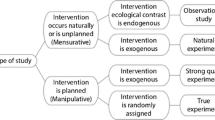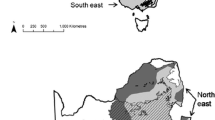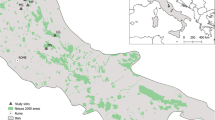Abstract
Certain neglected concepts for studying vegetation dynamics are reviewed, particularly the incorporating of temporal and spatial heterogeneity; examples are given. Few studies have been of sufficient length to allow partition of the various types of temporal fluctuation influencing vegetation composition. Studies of changes in spatial pattern with time are similarly few. The formation of patches of vegetation and their change with time (nucleation) may determine the entire spatio-temporal structure of the ecosystem, e.g. vegetation groves in arid zones. Simultaneous study of temporal and spatial heterogeneity is required. Future studies will necessitate higher standards of evidence than previously accepted. The practice of equating a few spatially separated sites having different periods of time since a specific disturbance should not be accepted in the absence of evidence that their potential vegetation dynamics has been similar during those periods.
Permanent quadrats with an appropriate experimental design are needed to overcome these problems. The requirements to be met by such a design are discussed, including the role of location, contiguity, perturbation or synthetic experimentation and demographic measurement.
Similar content being viewed by others
References
Albertson, F. W. & Tomanek, G. W., 1965. Vegetation changes during a 30-year period in grassland communities near Hays, Kansas. Ecology 46: 714–720.
Austin, M. P., 1968. Pattern in a Zerna erecta dominated community. J. Ecol. 56: 197–218.
Austin, M. P., 1977. Use of ordination and other multivariate descriptive methods to study succession. Vegetatio 35: 165–175.
Austin, M. P., 1980. Exploratory analysis of grassland dynamics, an example of a lawn succession. Vegetatio 43: 87–94.
Austin, M. P. & Austin, B. O., 1980. Behaviour of experimental plant communities along a nutrient gradient. J. Ecol. 68: 891–918.
Austin, M. P. & Belbin, L., 1981. An analysis of succession along an environmental gradient using data from a lawn. Vegetatio 46: 19–30.
Austin, M. P., Williams, O. B. & Belbin, L., 1981. Grassland dynamics in an Australian Mediterranean type climate. Vegetatio 47: 201–211.
Barclay-Estrup, P. & Gimingham, C. H., 1969. The description and interpretation of cyclical processes in a heath community. I. Vegetational change in relation to the Calluna cycle. J. Ecol. 57: 737–758.
Beeftink, W. G., 1979. Vegetation dynamics in retrospect and prospect. Introduction to the Proceedings of the Second Symposium of the Working Groups on Succession Research on Permanent Plots. Vegetatio 40: 101–105.
Bergh, J. P., van den., 1979. Changes in the composition of mixed populations of grassland species. In: M. J. A., Werger (ed.) The study of vegetation, p. 57–80. Junk, The Hague.
Boaler, S. B. & Hodge, C. A. H., 1962. Vegetation stripes in Somaliland. J. Ecol. 50: 465–74.
Boaler, S. B. & Hodge, C. A. H., 1964. Observations on vegetation arcs in the Northern Region, Somali Republic. J. Ecol. 52: 511–44.
Boyd, D. A., 1973. Development in field experimentation with fertilizers. Phosphorus Agri. 61: 7–17.
Colinvaux, P. A., 1973. Introduction to Ecology. Wiley, New York, 621 pp.
Connell, J. H., 1976. Some mechanisms producing structure in natural communities. In: M. L., Cody & J. M., Diamond, (eds.) Ecology & evolution of communities' Belhamp Press, Cambridge, Mass. 545 pp.
Connell, J. H. & Slatyer, R. O., 1977. Mechanisms of succession in natural communities and their role in community stability and organisation. Am. Nat. 111: 1119–1144.
Cooper, W. S., 1923. The recent ecological history of Glacier Bay, Alaska. III. Permanent quadrats at Glacier Bay: an initial report upon a long period study. Ecology 4: 355–365.
Cooper, W. S., 1931. A third expedition to Glacier Bay, Alaska. J. Ecol. 12: 61–95.
Cooper, W. S., 1939. A fourth expedition to Glacier Bay, Alaska. Ecology 20: 130–155.
Crocker, R. L. & Major, J., 1955. Soil development in relation to vegetation and surface age at Glacier Bay, Alaska. J. Ecol. 43: 427–448.
Drury, W. H. & Nisbet, I. C. T., 1973. Succession. J. Arnold Arboretum 54: 331–368.
Egler, F. E., 1954. Vegetation science concepts. I. Initial floristic composition. A factor in old-field vegetation development. Vegetatio 4: 412–417.
Egler, F. E., 1977. The nature of vegetation, its management and mismanagement. An introduction to vegetation science. Aton Forest Norfolk, Connecticut. Privately published.
Ellenberg, H., 1953. Physiologisches und ökologisches Verhalten derselben Pflanzenarten. Ber. Dtsch. Bot. Ges. 65: 351–362.
Ellenberg, H., 1954. Über enige Fortschritte der kausalen Vegetationskunde. Vegetatio 5/6: 199–211.
Greig-Smith, P., 1964. Quantitative plant ecology. 2nd ed. Butterworths, London, 256 pp.
Greig-Smith, P., 1979. Presidential address 1979: pattern in vegetation. J. Ecol. 67: 755–779.
Grubb, P. J., 1977. The maintenance of species-richness in plant communities: the importance of the regeneration niche. Biol. Rev. 52: 107–145.
Harberd, D. J., 1961. Observations on populations structure and longevity of Festuca rubra L. New Phytol. 60: 184–206.
Harberd, D. J. & Owen, M., 1969. Some experimental observations on the clone structure of a natural population of Festuca rubra L. New Phytol. 60: 184–206.
Harberd, D. J. & Owen, M., 1969. Some experimental observations on the clone structure of a natural population of Festuca rubra L. New Phytol. 68: 93–104.
Harper, J. L., 1977. Population biology of plants. Academic Press, London. 892 pp.
Harper, J. L. & White, J., 1974. The demography of plants. Ann. Rev. Ecol. Syst. 5: 419–463.
Hemming, G. F., 1965. Vegetation arcs in Somaliland. J. Ecol 53: 57–68.
Jones, M. E., 1932. Grassland management and its influence on the sward. I. Factors influencing the growth of pasture plant. Empire J. Exp. Agr. 1: 43–57.
Kershaw, K. A., 1973. Quantitative and dynamic ecology. 2nd ed. Edward Arnold, London. 308 pp.
Lacy, C. J., 1972. Factors influencing occurrence of Cypress Pine vegetation in New South Wales. New South Wales For. Comm. Tech. Paper. 21.
Lawrence, D. B., 1958. Glaciers and vegetation in south-eastern Alaska. Am. Sci. 46: 89–122.
Lawrence, D. B., Shoenike, R. E., Quispel, A. & Bond, E., 1967. The role of Dryas drummondii in vegetation development following ice recession at Glacier Bay, Alaska with special reference to its nitrogen fixation by root nodules. J. Ecol. 55: 793–814.
Maarel, E., van der., 1971. Plant species diversity in relation to management. In: A. S., Watt & E., Duffey (eds.) The scientific management of animal and plant communities for conservation, pp. 45–63. Blackwell, Oxford.
Maarel, E., van der., 1981. Fluctuations in a coastal dune grassland due to fluctuations in rainfall: experimental evidence. Vegetatio 47: 259–265.
Maarel, E., van der & Werger, M. J. A., 1978. On the treatment of succession data. Phytocoenosis 7: 257–258.
Matthews, J. A. 1979a. A study of the variability of some successional and climax plant assemblage-types using multiple discriminant analysis. J. Ecol. 67: 225–271.
Matthews, J. A., 1979b. The vegetation of Storbreen gletschervorfelt Jotunheimen, Norway. I. Introduction and approaches involving classification. J. Biogeogr. 6: 17–47.
Matthews, J. A., 1979c. The vegetation of Storbreen gletschervorfeld Jotunheimen, Norway. II. Approaches involving ordination and general conclusions. J. Biogeogr. 133–167.
McCormick, J. F., 1968. Succession. Via (Philadelphia) I: 22–36.
McCormick, J. F., Lugo, A. E. & Charitz, R. R., 1974. Experimental analysis of ecosystems. In: B. R., Strain & W. D., Billings (eds.) Vegetation and environment, Handbook of vegetation science Part VI, Junk, The Hague. 195 pp.
MacIntosh, R. P., 1980. The relationship between succession and the recovery process in ecosystems. In: J., Cairns (ed.) The recovery process in damaged ecosystems. Ann Arbor Sci. Publ. Inc., Ann Arbor Mich.
Miles, J., 1979. Vegetation dynamics. Outline studies in ecology. Chapman and Hall, London, 80 pp.
Noble, I. R. in press. Predicting successional change. In: H. A. Mooney, J. M. Borricksen, N. L. Christensen, J. E. Lotan & W. A. Renness (eds.) Fire regimes and ecosystem properties. USDA For. Serv. Gen. Techn. Rep., Washington.
Noble, I. R. & Slatyer, R. O., 1980. The use of vital attributes to predict successional changes in plant communities subject to recurrent disturbances. Vegetatio 43: 5–21.
Odum, E. P., 1969. The strategy of ecosystem development. Science 164: 262–270.
Oinonen, E., 1967a. Sporal regeneration of bracken (Pteridium aquilinum (L.) Kuhn.) in Finland in the light of the dimensions and age of its clones. Acta For. Fenn. 83(1): 1–96.
Oinonen, E., 1967b. The correlation between the size of Finnish bracken (Pteridium a quilinum (L.) Kuhn.) clones and certain periods of site history. Acta For. Fenn. 83(2): 1–51.
Oinonen, E., 1967c. Sporal regeneration of ground pine (Lycopodium complanatum L.) in southern Finland in the light of the dimensions and ages of its clones. Acta For. Fenn. 83(3).
Perry, R. A., 1970. The effects on grass and browse production of various treatments on a mulga community in central Australia. In: M. J. T. Norman, (ed.) Proc. XIth Int. Grassland Congress.
Poole, R. W., 1974. An introduction to quantitative ecology. (McGraw Hill series in population biology) McGraw Hill, Tokyo. 532 pp.
Sarukhan, J. & Harper, J. L., 1973. Studies on plant demography: Ranunculus repens L., R. bulbosus L. and R. acris. I. Population flux and survivorship. J. Ecol. 61: 675–716.
Silvertown, J., 1980. The dynamics of a grassland ecosystem: botanical equilibrium in the Park Grass Experiment. J. Appl. Ecol. 17: 491–504.
Slatyer, R. O., 1961. Methodology of a water balance study conducted on a desert woodland (Acacia aneura F. Muell.) community in central Australia. Arid Zone Res. XVI Plantwater relationships in arid and semi-arid conditions. Proc. Madrid Symposium UNESCO.
Slatyer, R. O., 1965. Measurements of precipitation interception by an arid zone plant community (Acacia aneura F. Muell.). In: F. E. Eckart (ed.) Arid Zone Research XXV. Methodology of plant eco-physiology. Montpellier Symposium, UNESCO.
Slatyer, R. O. (ed.) 1976. Dynamic changes in terrestrial ecosystems: patterns of change, technique for study and application to management. UNESCO-MAB Techn. Notes 4.
Swaine, M. & Greig-Smith, P., 1980. An application of principal components analysis to vegetation change in permanent plots. J. Ecol. 68: 33–41.
Tamm, C. O., 1948. Observations on reproduction and survival of some perennial herbs. Bot. Not. 3: 305–321.
Tamm, C. O., 1956. Further observations on the survival and flowering of some perennial herbs. Oikos 7: 274–292.
Tamm, C. O., 1972. Survival and flowering of some perennial herbs. III. The behaviour of Primula veris on permanent plots. Oikos 23: 159–166.
Usher, M. B., 1981. Modelling ecological succession, with particular reference to Markovian models. Vegetatio 46: 11–18.
Vasek, F. C., 1980. Creosote bush: long-lived clones in the Mojave Desert. Am. J. Bot. 67: 246–255.
Walker, D., 1971. Direction and rate in some British postglacial hydroseres. In: D. Walker & R. West (eds.) The vegetational history of the British Isles, p. 117–139. Cambridge Univ. Press.
Watt, A. S., 1947a. Pattern and process in the plant community. J. Ecol. 35: 1–22.
Watt, A. S., 1947b. Contributions to the ecology of bracken. IV. The structure of the community. New Phytol. 46: 97–121.
Watt, A. S., 1955. Bracken versus heather, a study in plant sociology. J. Ecol. 43: 490–506.
Watt, A. S., 1957. The effect of excluding rabbits from grassland B (Mesobrometum) in Breckland. J. Ecol. 45: 861–878.
Watt, A. S., 1960. Population changes in acidiphilous grassheath in Breckland, 1936–57. J. Ecol. 48: 605–629.
Watt, A. S., 1962. The effects of excluding rabbits from grassland A (Xerobrometum) in Breckland, 1937–60. J. Ecol. 50: 181–198.
Watt, A. S., 1971. Factors controlling the floristic composition of some plant communities in Breckland. In: E., Duffey & A. S., Watt (eds.) The scientific management of animal & plant communities for conservation, p. 137–152. Blackwell, Oxford.
White, L. P., 1969. Vegetation arcs in Jordan. J. Ecol. 57: 461–64.
White, L. P., 1970. Broussee tigree patterns in Southern Niger. J. Ecol. 58: 549–554.
White, L. P., 1971. Vegetation stripes on sheet wash surfaces. J. Ecol. 59: 615–22.
Williams, E. D., 1978. Botanical composition of the Park Grass plots at Rothamsted 1856–1976. Rothamsted Expt. Harpenden. 61 pp.
Williams, O. B., 1969. Studies in the ecology of the riverine plain. V. Plant density response of species in a Danthonia caespitosa grassland to sixteen years of grazing by Merino sheep. Aust. J. Bot. 17: 225–68.
Williams, O. B., 1970. Populations dynamics of two perennial grasses in Australian semi-arid grassland. J. Ecol. 58: 869–875.
Williams, O. B. & Roe, R., 1975. Management of arid zone grasslands for sheep. In: ‘Managing terrestrial ecosystems’. Proc. Ecol. Soc. Aust. 9: 142–156.
Willis, A. J., 1972. Long-term ecological changes in sward composition following application of Maleic hydrozide and 2,4-D. Proc. 11th Brit. Weed Control Conf. 360–367.
Worrall, G. A., 1959. The Butana grass patterns. J. Soil. Sci. 10: 34–53.
Worrall, G. A., 1960. Tree patterns in the Sudan. J. Soil Sci. 11: 63–7.
Yarranton, G. A. & Morrison, R. G., 1974. Spatial dynamics of a primary succession: nucleation. J. Ecol. 62: 417–428.
Author information
Authors and Affiliations
Additional information
I thank J. F. Angus, O. B. Williams and A. O. Nichols for comments on the manuscript and C. helman for bibliographic assistance.
Rights and permissions
About this article
Cite this article
Austin, M.P. Permanent quadrats: An interface for theory and practice. Vegetatio 46, 1–10 (1981). https://doi.org/10.1007/BF00118379
Accepted:
Published:
Issue Date:
DOI: https://doi.org/10.1007/BF00118379




